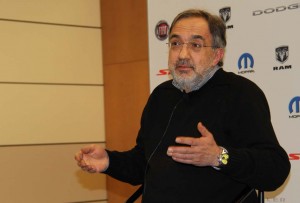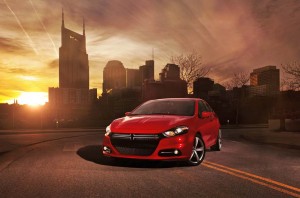Chrysler is sharply scaling back its plans for the U.S. roll-out of the Italian Fiat brand following an unexpectedly slow launch last year, but Sergio Marchionne, who serves as CEO of both sides of the trans-Atlantic Chrysler-Fiat alliance, insists that the shortfall does not mean the Italian brand has failed in its bid to return to the U.S. market after a decades-long absence.
In a roundtable session with reporters during the 2012 North American International Auto Show, Marchionne said he expects to cut by roughly half the number of cars Fiat expects to sell in the U.S. until it can better establish itself with additional products beyond the pint-sized Fiat 500 that debuted a little over a year ago — admitting the initial forecasts were “incredibly naive.”
In a wide-ranging conversation, the Canadian-educated executive also noted that given the ongoing problems with Europe’s economy – as well as resistance to change by Italian unions — he is given serious thought to moving more of Fiat’s headquarters operations to the U.S.
The one thing Marchionne said he has “not a single doubt about,” 30 months after Fiat helped pull Chrysler out of bankruptcy, is that “Fiat needs Chrysler as much as Chrysler needs Fiat.”
Most industry observers have been surprised, perhaps even shocked, by the pace at which the U.S. maker has recovered since its turn in Chapter 11. It saw double-digit sales gains last year and a sharp improvement in its bottom line.
Marchionne has earned plenty of kudos, in turn, for his aggressive command of both Chrysler and Fiat, with a strong emphasis on merging and streamlining their operations. Among other things, he noted that the two companies are on track to cut back from “over a dozen different vehicle platforms, or “architectures,” to just five in the next few years, significantly improving economies of scale.
But Marchionne cautioned that the company he is melding from the two separate firms still has some serious problems, especially in Europe. “If we run into additional difficulties (there) beyond where we are,” he said, “we will shift our resources to North America,” at Chrysler’s headquarters in the Detroit suburb of Auburn Hills.
There are other challenges, Marchionne acknowledged. He described as a “work in progress” the effort to get the various Fiat-Chrysler brands focused, Italy’s Alfa Romeo in particular. The original goal was to bring Alfa back to the U.S. this past year, but without the sort of luxury products that could justify a premium price Marchionne ordered Alfa to postpone that move.
“Alfa has to be a premium brand or I won’t do it,” he told the gathered media.
That’s a problem not only for Alfa itself but for the Fiat brand, as they were expected to share dealer showrooms. Making matters worse, Fiat missed its 50,000-unit sales goal for the U.S. in 2011 by more than half and likely won’t get to that level any time soon, “20,000 being more realistic,” with another 5,000 sales in Canada.
What will help put Fiat back on track, he said, is more product. A European-sized people-move, or microvan, is under development, with “another” European model set for a 2013 launch, Alfa to come after that according to current plans.
The Detroit Auto Show marks a critical step in the partnership between Chrysler and Fiat, bringing the debut of the new Dodge Dart, which uses a new architecture adopted from Fiat’s Alfa brand that will eventually serve as the platform for a wide variety of global products.
The new compact sedan will be priced well below the competition in a bid to gain some attention in a crowded market. “I don’t make a lot of money” on Dart, Marchionne conceded, but he is hoping that will help drive more business to the Dodge franchise and improve its economies of scale.
Another step in the consolidation process will come with the launch of a new Maserati sport-utility vehicle based on the same platform as the Jeep Grand Cherokee. Unveiled at last autumn’s Frankfurt Motor Show, it was dubbed Kubang, but Marchionne promised to find another name for it.
“Nobody likes (the name),” he confided, “not even me.”



The one thing Marchionne said he has “not a single doubt about,” 30 months after Fiat helped pull Chrysler out of bankruptcy, is that “Fiat needs Chrysler as much as Chrysler needs Fiat.”
Or, Marchionne needs to dig deeper into its inventions/patents, especially the MultiAir or TwinAir or UniAir or whatever they call it, to find out that Fiat has invented the way to turn the old Internal Combustion Engine into a Digital Device of the Digital Age.
By programming it to work according the Miller-Cycle, Marchionne gets a better mileage than with its Diesel cars, hence much better CO2, NOx, particles etc emissions.
Basic thermodynamics tell that the infinite Miller-Cycles this invention of Fiat provides, reduces the Combustion Temperature of the engine several hundreds of degrees, with all the good stuff coming out of it (MultiAir gets the Coldest and thereby the Cool engine).
Similar things are being told by the Alfa Romeo prototype: http://www.pattakon.com/pattakonHydro.htm
Though, it seems that, by replacing its original turbocharger by a supercharger like the one of Nissan Micra, which, in turn, enables the 14:1 compression ratio of the Mazda Skyactiv G, more power and even better mileage are possible.
Thanks
Manousos Pattakos